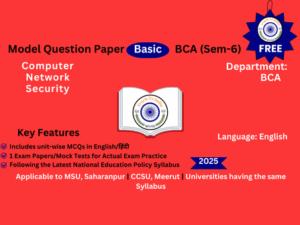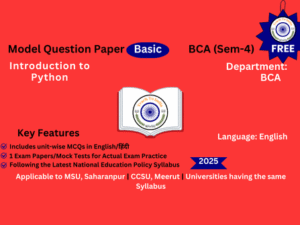Organic Synthesis-B - कार्बनिक संश्लेषण - ख – Adv
- Description
- Curriculum
- Reviews

Model Question Paper
Organic Synthesis-B – कार्बनिक संश्लेषण – ख
Key Features | मुख्य विशेषताएँ
-
Bilingual Model Paper | द्विभाषी मॉडल पेपर
This model paper is Designed in English and Hindi, making it easier for students from both mediums to understand and practice effectively.
यह मॉडल पेपर अंग्रेज़ी और हिंदी दोनों भाषाओं में डिज़ाइन किया गया, जिससे दोनों माध्यमों के छात्रों को अध्ययन और अभ्यास करने में आसानी हो। -
Unit-wise Short Notes | इकाईवार संक्षिप्त नोट्स
Each unit includes a summary in both languages, making revision faster and more effective.
प्रत्येक इकाई में दोनों भाषाओं में सारांश उपलब्ध है, जिससे पुनरावृत्ति तेज़ और प्रभावी हो सके। -
Extensive MCQ Practice | विस्तृत MCQ प्रैक्टिस
1500+ MCQ Practice Questions: This comprehensive question bank includes 1500+ multiple-choice questions (MCQs). Each unit contains approximately 150 MCQs covering a wide range of cognitive levels such as remembering, understanding, application, and analysis.
1500+ MCQ अभ्यास प्रश्न: इस प्रश्न बैंक में 1500 से अधिक बहुविकल्पीय प्रश्न (MCQ) शामिल हैं। प्रत्येक यूनिट में लगभग 150 MCQ हैं, जो याददाश्त, समझ, अनुप्रयोग और विश्लेषण जैसे विभिन्न संज्ञानात्मक स्तरों को कवर करते हैं। -
Exam Practice Paper with Mock Tests | मॉक टेस्ट के साथ परीक्षा अभ्यास पत्र
Includes three full-length mock tests for real exam practice.
तीन पूर्ण मॉक टेस्ट दिए गए हैं, जिससे छात्र वास्तविक परीक्षा अभ्यास कर सकें। -
Latest Syllabus as per NEP | NEP के अनुसार नवीनतम पाठ्यक्रम
The syllabus aligns with the latest National Education Policy (NEP) and follows the exam patterns of MSU, CCSU, and other universities following the NEP.
पाठ्यक्रम नवीनतम राष्ट्रीय शिक्षा नीति (NEP) के अनुसार है और यह MSU, CCSU तथा अन्य NEP का पालन करने वाले विश्वविद्यालयों की परीक्षा प्रणाली का अनुसरण करता है। -
Designed by Experts | विशेषज्ञों द्वारा तैयार किया गया
This question bank has been meticulously prepared by subject matter experts to ensure accuracy and relevance.
यह प्रश्न बैंक विषय विशेषज्ञों द्वारा सावधानीपूर्वक तैयार किया गया है, जिससे इसकी सटीकता और प्रासंगिकता बनी रहे।
Why Choose This Model Paper? | यह मॉडल पेपर क्यों चुनें?
-
Dual-Language Advantage: Ideal for both English and Hindi medium students.
द्विभाषी लाभ: अंग्रेज़ी और हिंदी दोनों माध्यमों के छात्रों के लिए उपयुक्त। -
Complete Exam Preparation: Unit-wise summaries, MCQ practice, and mock tests provide a complete study solution.
पूर्ण परीक्षा तैयारी: इकाईवार सारांश, MCQ अभ्यास, और मॉक टेस्ट संपूर्ण अध्ययन समाधान प्रदान करते हैं। -
Latest NEP-Based Pattern: Ensures compliance with the latest university exam structure.
नवीनतम NEP-आधारित पैटर्न: यह नवीनतम विश्वविद्यालय परीक्षा संरचना के अनुरूप है।
|
Program/Class: Degree/ Bachelor of Science |
Year: Third |
Semester: Sixth |
||
|
Subject: Chemistry |
||||
|
Course Title: Organic Synthesis B |
||||
|
Course Learning Outcomes This paper provides detailed knowledge of synthesis of various class of organic compounds and functional groups inter conversion. Organic synthesis is the most important branch of organic chemistry which provides jobs in production & QC departments related to chemicals, drugs, medicines, FMCG etc. industries. The study of natural products and heterocyclic compounds offers an excellent strategy toward identifying novel biological probes for a number of diseases. Historically, natural products have played an important role in the development of pharmaceutical drugs for a number of diseases including cancer and infection. ∙ It relates and gives an analytical aptitude for synthesizing various industrially important compounds. ∙ Learn the different types of alkaloids, & terpenes etc and their chemistry and medicinal importance. ∙ Explain the importance of natural compounds as lead molecules for new drug discovery.
|
||||
|
Credits: 4 |
Core Compulsory |
|||
|
Max. Marks: –25+75 |
Min. Passing Marks: 40 |
|||
|
Unit |
Topics |
|||
|
I |
Reagents in Organic Synthesis A detailed study of the following reagents in organic transformations Oxidation with DDQ, CAN and SeO2, mCPBA, Jones Oxidation, PCC, PDC, PFC, Collin’s reagent and ruthenium tetraoxide. Reduction with NaBH4, LiAlH4, Meerwein-Ponndorf-Verley (MPV) reduction, Wilkinson’s catalyst, Birch reduction, DIBAL-H
|
|||
|
II |
Organometallic Compounds-Organomagnesium compounds: the Grignard reagents, formation, structure and chemical reactions. Organozinc compounds: formation and chemical reactions. Organolithium compounds: formation and chemical reactions.
|
|||
|
III |
Chemistry of Aldehydes and ketones: Nomenclature and structure of the carbonyl groups, synthesis of aldehydes and ketones with particular reference to the synthesis of aldehydes from acid chlorides, synthesis of aldehydes and ketones uses 1, 3-dithianes, synthesis of ketones from nitrites and from carboxylic acids, Physical properties. Mechanism of nucleophillic additions to carbonyl group with particular emphasis on benzoin, aldol, Perkin and Knoevenagel condensations, Condensation with ammonia and its derivatives. Wittig reaction, Mannich reaction. Oxidation of aldehydes, Cannizzaro reaction, MPV, Clemmensen, Wolff-Kishner, LiAlH4 and NaBH4 reductions. Halogenation of enolizable ketones An introduction to α, β unsaturated aldehydes and Ketones
|
|||
|
IV |
Carboxylic acids and their Functional Derivatives Nomenclature and classification of aliphatic and aromatic carboxylic acids. Preparation and reactions. Acidity (effect of substituents on acidity) and salt formation, Reactions: Mechanism of reduction, substitution in alkyl or aryl group. Preparation and properties of dicarboxylic acids such as oxalic, malonic, succinic, glutaric, adipic and phthalic acids and unsaturated carboxylic acids such as acrylic, crotonic and cinnamic acids, Reactions: Action of heat on hydroxy and amino acids, and saturated dicarboxylic acids, stereospecific addition to maleic and fumaric acids. Preparation and reactions of acid chlorides, acid anhydrides, amides and esters, acid and alkaline hydrolysis of esters, trans-esterification.
|
|||
|
V |
Organic Synthesis via Enolates Acidity of α-hydrogens, alkylation of diethyl malonate and ethyl acetoacetate, Synthesis of ethyl acetoacetate: the Claisen condensation, Keto-enol tautomerism of ethyl acetoacetate. Alkylation of 1, 3-dithianes, Alkylation and acylation of enamines.
|
|||
|
VI |
Organic Compounds of Nitrogen- Preparation of nitroalkanes and nitroarenes, Chemical reactions of nitroalkanes. Mechanisms of nucleophilic substitution in nitroarenes and their reductions in acidic, neutral and alkaline media, Picric acid. Halonitroarenes: reactivity, Structure and nomenclature of amines, physical properties, Stereochemistry of amines, Separation of a mixture of primary, secondary and tertiary amines. Structural features effecting basicity of amines. Amine salts as phase-transfer catalysts, Preparation of alkyl and aryl amines (reduction of nitro compounds, nitrities), reductive amination of aldehydic and ketonic compounds, Gabriel phthalimide reaction, Hofmann bromamide reaction. Reactions of amines, electrophilic aromatic substituton in aryl amines, reactions of amines with nitrous acid. Synthetic transformations of aryl diazonium salts, azo coupling
|
|||
|
VII |
Heterocyclic Chemistry Molecular orbital picture and aromatic characteristics of pyrrole, furan, thiophene and pyridine, Methods of synthesis and chemical reactions with particular emphasis on the mechanism of electrophilic substitution, Mechanism of nucleophilic substitution reaction in pyridine derivatives, Comparison of basicity of pyridine, piperidine and pyrrole. Introduction to condensed five and six membered heterocycles, Preparation and reactions of indole, quinoline and isoquinoline with special reference to Fisher indole synthesis, Skraup synthesis and Bischler-Nepieralski synthesis, Mechanism of electrophilc substitution reactions of indole, quinoline and isoquinoline
|
|||
|
VIII |
Natural Products Alkaloids & Terpenes: Natural occurrence, General structural features, their physiological action, Hoffmann’s exhaustive methylation, Emde’s modification;. Medicinal importance of Nicotine, Hygrine, Quinine, Morphine, Cocaine, and Reserpine. Natural Occurrence and classification of terpenes, isoprene rule
|
|||
-
1Unit 1: English Summary - Organic Synthesis-B
-
2Unit 1: Hindi Summary - Organic Synthesis-B
-
3Unit 1: MCQs - Organic Synthesis-B- Adv
-
4Unit 2: English Summary - Organic Synthesis-B
-
5Unit 2: Hindi Summary - Organic Synthesis-B
-
6Unit 2: MCQs - Organic Synthesis-B- Adv
-
7Unit 3: English Summary - Organic Synthesis-B
-
8Unit 3: Hindi Summary - Organic Synthesis-B
-
9Unit 3: MCQs - Organic Synthesis-B- Adv
-
10Unit 4: English Summary - Organic Synthesis-B
-
11Unit 4: Hindi Summary - Organic Synthesis-B
-
12Unit 4: MCQs - Organic Synthesis-B- Adv
-
13Unit 5: English Summary - Organic Synthesis-B
-
14Unit 5: Hindi Summary - Organic Synthesis-B
-
15Unit 5: MCQs - Organic Synthesis-B- Adv
-
16Unit 6: English Summary - Organic Synthesis-B
-
17Unit 6: Hindi Summary - Organic Synthesis-B
-
18Unit 6: MCQs - Organic Synthesis-B- Adv
-
19Unit 7: English Summary - Organic Synthesis-B
-
20Unit 7: Hindi Summary - Organic Synthesis-B
-
21Unit 7: MCQs - Organic Synthesis-B- Adv
-
22Unit 8: English Summary - Organic Synthesis-B
-
23Unit 8: Hindi Summary - Organic Synthesis-B
-
24Unit 8: MCQs - Organic Synthesis-B- Adv







